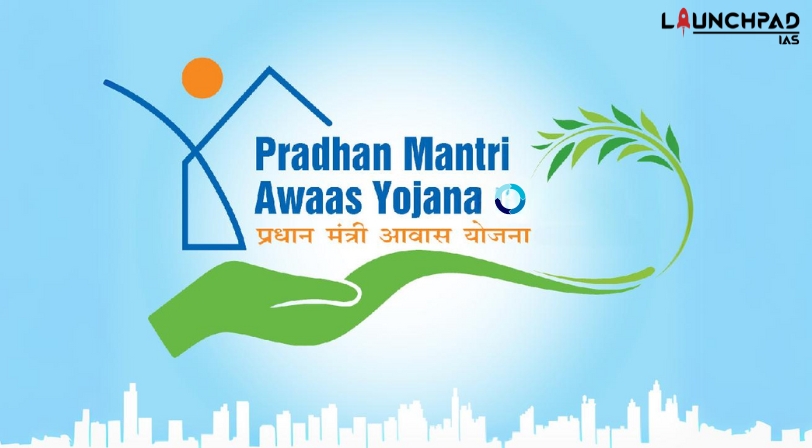About PMAY- Urban:
- Pradhan Mantri Awas Yojana (PMAY) is launched by the Ministry of Housing and Urban Poverty Alleviation (MoHUPA) in Mission mode.
- It envisions the provision of Housing for All by 2022 when the Nation completes 75 years of its Independence. Now the scheme has been extended till 2024.
- The Pradhan Mantri Awas Yojana (PMAY) Mission seeks to address the housing requirement of the urban poor including slum dwellers through the following program verticals:
- Slum rehabilitation of Slum Dwellers with the participation of private developers using land as a resource.
- Promotion of Affordable Housing for weaker sections through credit-linked subsidy.
- Affordable Housing in Partnership with Public & Private sectors.
- Subsidy for beneficiary-led individual house construction /enhancement.
Who is eligible for the PMAY scheme?
- The maximum age limit of the beneficiary is 70 years.
- The beneficiary should have a family that comprises of husband, wife, and unmarried children.
- The beneficiary should not own a Pucca House either in their name or in the name of any member of the family in any state of India.
- The annual income should be between 3 lakhs to 6 lakhs if the beneficiary is from LIG (Low Income Group).
- Membership of one adult female member of the family is mandatory in ownership of the house.
Components of Housing for All Scheme:
There are four components:
In-situ Slum Redevelopment (ISSR)
- Central assistance of Rs. 1 lakh per house is available for all houses constructed for eligible slum residents under the ISSR component.
- The State/UT Government de-notify slums after rebuilding.
- States and cities are allowed the freedom to use this central assistance for the redevelopment of additional slums.
Credit Linked Subsidy Scheme (CLSS)
Beneficiaries of the Economically Weaker Section (EWS)/Low Income Group (LIG), Middle Income Group (MIG)-I- and Middle-Income Group (MIG-II), and other such institutions, are eligible for interest subsidies of 6.5%, 4%, and 3% on loans up to Rs. 6 lakhs, Rs. 9 lakhs, and Rs. 12 lakhs, respectively, for purchasing, building new homes, or improving existing homes.
Affordable Housing in Partnership (AHP)
- The Indian government offers Central Assistance under AHP in the amount of Rs. 1.5 lakh for every EWS housing.
- A project for affordable housing may include a mix of homes for various income levels. It will only be qualified for Central Assistance if at least 35% of the project’s homes fall under the EWS category.
Beneficiary-led Individual House Construction/ Enhancement (BLC-N/BLC-E)
- Eligible households from EWS categories are given central assistance up to Rs. 1.5 lakh per EWS category for home building or improvement.
- The Urban Local Bodies validate the building plan and information that the beneficiary has provided. Based on the information, they determine land ownership and other information like economic situation and eligibility.
PMAY-Gramin Scheme:
- Launch: To achieve the objective of “Housing for All” by 2022, the erstwhile rural housing scheme Indira Awaas Yojana (IAY) was restructured to Pradhan Mantri Awaas Yojana-Gramin (PMAY-G) w.e.f 1st April, 2016.
- Ministry Involved: Ministry of Rural Development.
- Aim:
- To provide a pucca house with basic amenities to all rural families, who are homeless or living in kutcha or dilapidated houses by the end of March 2022.
- To help rural people Below the Poverty Line (BPL) in the construction of dwelling units and upgradation of existing unserviceable kutcha houses by assisting in the form of a full grant.
- Beneficiaries: People belonging to SCs/STs, freed bonded laborers and non-SC/ST categories, widows or next-of-kin of defense personnel killed in action, ex-servicemen and retired members of the paramilitary forces, disabled persons, and minorities.
- Selection of Beneficiaries: Through a three-stage validation – Socio-Economic Caste Census 2011, Gram Sabha, and geo-tagging.
- Cost Sharing: The cost of unit assistance is shared between Central and State Governments in the ratio of 60:40 in plain areas and 90:10 for North Eastern and hilly states.
- Achievements:
- It was initiated with a target of completing 2.7 crore houses.
- So far, according to the database maintained by the Union Rural Development Ministry, 1.8 crore houses have been constructed.
- This is 67.72% of the target.


